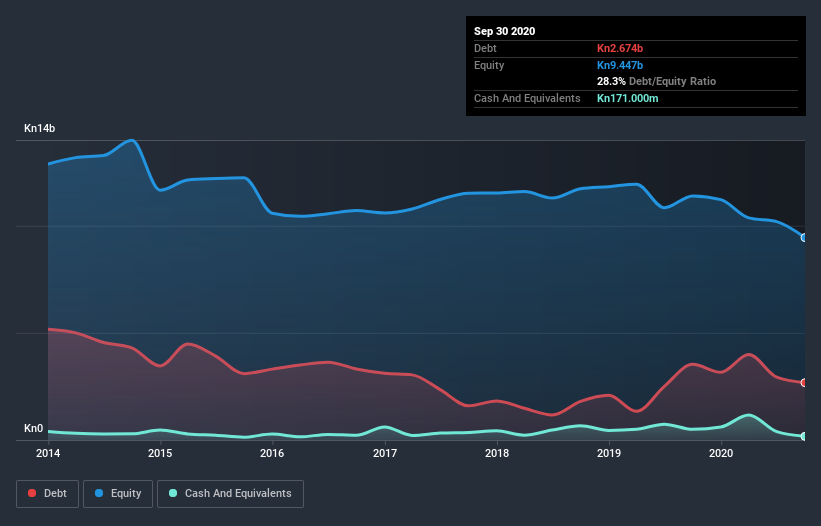
Howard Marks put it nicely when he said that, rather than worrying about share price volatility, 'The possibility of permanent loss is the risk I worry about... and every practical investor I know worries about.' It's only natural to consider a company's balance sheet when you examine how risky it is, since debt is often involved when a business collapses. We note that INA-Industrija nafte, d.d. (ZGSE:INA) does have debt on its balance sheet. But is this debt a concern to shareholders?
Why Does Debt Bring Risk?
Debt is a tool to help businesses grow, but if a business is incapable of paying off its lenders, then it exists at their mercy. Part and parcel of capitalism is the process of 'creative destruction' where failed businesses are mercilessly liquidated by their bankers. However, a more frequent (but still costly) occurrence is where a company must issue shares at bargain-basement prices, permanently diluting shareholders, just to shore up its balance sheet. Having said that, the most common situation is where a company manages its debt reasonably well - and to its own advantage. When we examine debt levels, we first consider both cash and debt levels, together.
View our latest analysis for INA-Industrija nafte d.d
What Is INA-Industrija nafte d.d's Debt?
You can click the graphic below for the historical numbers, but it shows that INA-Industrija nafte d.d had Kn2.67b of debt in September 2020, down from Kn3.53b, one year before. However, it does have Kn171.0m in cash offsetting this, leading to net debt of about Kn2.50b.

A Look At INA-Industrija nafte d.d's Liabilities
The latest balance sheet data shows that INA-Industrija nafte d.d had liabilities of Kn6.10b due within a year, and liabilities of Kn4.09b falling due after that. Offsetting these obligations, it had cash of Kn171.0m as well as receivables valued at Kn1.59b due within 12 months. So it has liabilities totalling Kn8.42b more than its cash and near-term receivables, combined.
While this might seem like a lot, it is not so bad since INA-Industrija nafte d.d has a market capitalization of Kn28.6b, and so it could probably strengthen its balance sheet by raising capital if it needed to. But it's clear that we should definitely closely examine whether it can manage its debt without dilution. The balance sheet is clearly the area to focus on when you are analysing debt. But it is INA-Industrija nafte d.d's earnings that will influence how the balance sheet holds up in the future. So if you're keen to discover more about its earnings, it might be worth checking out this graph of its long term earnings trend.
Over 12 months, INA-Industrija nafte d.d made a loss at the EBIT level, and saw its revenue drop to Kn18b, which is a fall of 24%. To be frank that doesn't bode well.
Caveat Emptor
Not only did INA-Industrija nafte d.d's revenue slip over the last twelve months, but it also produced negative earnings before interest and tax (EBIT). Indeed, it lost Kn1.1b at the EBIT level. When we look at that and recall the liabilities on its balance sheet, relative to cash, it seems unwise to us for the company to have any debt. So we think its balance sheet is a little strained, though not beyond repair. We would feel better if it turned its trailing twelve month loss of Kn1.2b into a profit. So to be blunt we do think it is risky. The balance sheet is clearly the area to focus on when you are analysing debt. But ultimately, every company can contain risks that exist outside of the balance sheet. Consider risks, for instance. Every company has them, and we've spotted 1 warning sign for INA-Industrija nafte d.d you should know about.
When all is said and done, sometimes its easier to focus on companies that don't even need debt. Readers can access a list of growth stocks with zero net debt 100% free, right now.
If you decide to trade INA-Industrija nafte d.d, use the lowest-cost* platform that is rated #1 Overall by Barron’s, Interactive Brokers. Trade stocks, options, futures, forex, bonds and funds on 135 markets, all from a single integrated account. Promoted
New: AI Stock Screener & Alerts
Our new AI Stock Screener scans the market every day to uncover opportunities.
• Dividend Powerhouses (3%+ Yield)
• Undervalued Small Caps with Insider Buying
• High growth Tech and AI Companies
Or build your own from over 50 metrics.
This article by Simply Wall St is general in nature. It does not constitute a recommendation to buy or sell any stock, and does not take account of your objectives, or your financial situation. We aim to bring you long-term focused analysis driven by fundamental data. Note that our analysis may not factor in the latest price-sensitive company announcements or qualitative material. Simply Wall St has no position in any stocks mentioned.
*Interactive Brokers Rated Lowest Cost Broker by StockBrokers.com Annual Online Review 2020
Have feedback on this article? Concerned about the content? Get in touch with us directly. Alternatively, email editorial-team@simplywallst.com.
About ZGSE:INA
INA-Industrija nafte d.d
Explores for, produces, refines, and sells oil and gas.
Adequate balance sheet with questionable track record.


